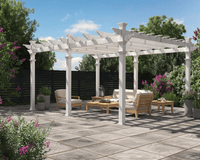Everyone wants their yield to be worth their time. You put hours, weeks, even months into your crops. So, you want a worthy harvest. That’s not too much to ask. I mean really, you put so much of your effort into it. You contemplated what you wanted to grow to suit your needs. You took the time and effort into planning your garden. You even went the extra mile and got the pH tester kit to ensure you have a healthy and well-balanced soil. Time invested into learning each plant’s health needs.
I mean really, you put so much of your effort into it. You contemplated what you wanted to grow to suit your needs. You took the time and effort into planning your garden. You even went the extra mile and got the pH tester kit to ensure you have a healthy and well-balanced soil. Time invested into learning each plant’s health needs.
You deserve a generous harvest, and there’s an easy way to learn how!
Beneficial gardening is all about maintaining a self-sustaining ecosystem; you want your garden to thrive, and you want it to be self sustaining. You know that understanding gardening goes beyond the roots. This is why we decided to take the guessing out of the game by compiling a list of plants we would choose in our dream Beneficial Garden.
Ideally, you would like these gardens to be somewhat sectioned out. Vita’s Beneficial Garden Bed is a perfect example of how you can arrange your garden to get the most yield out of your crop. We have our ideal garden sectioned out into 5 separate spaces.
Bed 1 - 2-ft x 4-ft x 7-⅜-" • Eggplant • Lavender • Rosemary • Lemongrass • Petunias • Chrysanthemum • Alliums • Marigolds
• Eggplant • Lavender • Rosemary • Lemongrass • Petunias • Chrysanthemum • Alliums • Marigolds
Bed 1 is your first line of defence. Here you will want to plant your most fragrant and bold flowers, herbs and veggies to attract beneficial pollinators and distract pests away from your produce. We recommend planting Marigolds, eggplant and rosemary in this bed.
Marigolds are classic ornamental flowers that are known for their bold, bright colors. They are well known to repel pesky insects such as aphids, squash bugs, and beetles. Marigolds serve well when planted next to veggies such as cucumbers, squash, potatoes, eggplants, beans, and onions (just to name a few).
Rosemary is a close friend of many veggies and a great addition to your garden. Planting rosemary can improve the flavor of its nearby companions, as well as acting as another scent barrier to protect your crops.
Eggplants require tons of nitrogen, sunlight, and water. Thankfully, rosemary and marigolds do not require too many nutrients from the soil (because you want as many nutrients as you can for your eggplant). Marigolds can deter beetles, while rosemary can repel pests such as moths, flies, and mosquitoes.
Bed 2 - 2-ft x 4-ft x 11" • Tomato • Eggplant • Peppers • Spinach • Sage • Rosemary
• Tomato • Eggplant • Peppers • Spinach • Sage • Rosemary
Bed 2 is where you will plant your nightshade vegetables. Your nightshade vegetables are your edible flowering plants from the “Solanaceae” family. Nightshade veggies typically get a bad reputation since they’re commonly associated with toxic plants, though many of these plants are staples of the typical American house. Some plants that fall into this category are tomatoes, eggplants, peppers, potatoes, and spinach.
These veggies are loaded with nutrients and have low calories. We recommend planting your tomatoes, eggplant, sage, and rosemary here.
Be careful when planting your tomatoes and eggplant. As we learned in bed 1, your eggplant requires a ton of sunlight and would not like to be shaded by your tower of tomatoes growing right next to it.
Sage grows very well with rosemary, and repels similar insects and pests as well. Sage repels snails, beetles, and moths and flies. Beyond that, rosemary is known to improve the quality of your sage and provides many benefits to your growing sage! Together, they make a powerful couple.
(Let your sage flower and you won’t regret it!)
Bed 3 - 2-ft x 4-ft x 11" • Cabbage • Kale • Brussel sprouts • Collards • Garlic • Dill • Parsley • Chives • Marigolds • Chamomile • Geranium
• Cabbage • Kale • Brussel sprouts • Collards • Garlic • Dill • Parsley • Chives • Marigolds • Chamomile • Geranium
Bed 3 should face East because this is where you will plant your early birdies. These plants thrive with the morning sun and will love you for it! Here, we recommend planting parsley, chives, cabbage and marigolds.
Parsley acts as a secret weapon in your garden by both repelling the harmful beetles we hate, and attracting the beneficial insects our garden needs! Chives behave similarly to parsley in regard to growing habits and the ability to repel beetles, aphids, and other undesirables.
Planting chives next to your cabbage will act as a great line of defense against cabbage maggots, cabbage worms, snails, beetles, aphids, and more. Cabbage is fairly easy to grow, but works perfectly in bed 3 due to its need for direct sunlight, and desire for shade from the afternoon heat. Pairing them next to your marigolds is a perfect way to allow for some shade against the hot summer sun!
Bed 4 - 4-ft x 4-ft x 18-⅜-" • Bell peppers • Tomatoes (a ton) • Asparagus • Celery • Chives • Rosemary • Sage • Thyme • Basil
• Bell peppers • Tomatoes (a ton) • Asparagus • Celery • Chives • Rosemary • Sage • Thyme • Basil
Bed 4 is for your sunbathers. We recommend planting your sage, basil, rosemary, thyme, and oregano here for extra flavor and health benefits! By growing these herbs together, you’re setting up each of your surrounding beds for success.
As we already know, sage and rosemary grow very well together. Another great companion is our friend, basil! Basil won’t just benefit your plants in bed 4, but it will also make a great impression on your tomatoes in bed 2! You’ll find that it adds a great flavor when grown near other veggies, while also distracting pests from your growing foods.
Plant your basil near marigolds and you’ll find that most of those pests end up turning away! Marigolds are an incredibly beneficial addition to almost any garden because of their aromatic flowers.
Oregano and thyme help to protect the nearby cabbage and eggplant from predatory insects. Planting these together will create a wonderful scent barrier and create a healthy and sustainable environment.
Bed 5 - 2-ft x 4-ft x 11" • Beets • Cabbage • Carrots • Lettuce • Onions • Chives • Dill • Parsley • Cilantro • Marigolds
• Beets • Cabbage • Carrots • Lettuce • Onions • Chives • Dill • Parsley • Cilantro • Marigolds
Bed 5 is the final bed to complete your Beneficial Garden. Here, we would recommend adding dill, cilantro, marigolds, and cabbage. Companion planting this variety is perfect for this bed since bed 4 will be blocking most of the morning sun. The additional hours of indirect sunlight will promote microclimate activity and spread the love throughout your garden.
Cabbage is such a people pleaser, it really grows well with most of my favourite herbs, including dill. Dill improves the health of local cabbage while also drawing in beneficial insects that will protect your garden. Cilantro behaves much like dill, where it will attract the beneficial pollinators that will prey on the pests. Now that you have your garden all mapped out, just let nature do the rest and don’t forget to do your basic maintenance. And it’s seriously this simple. Keep in mind that there is a whole list of plants that grow well together, but it’s important to know the ones to avoid.
Now that you have your garden all mapped out, just let nature do the rest and don’t forget to do your basic maintenance. And it’s seriously this simple. Keep in mind that there is a whole list of plants that grow well together, but it’s important to know the ones to avoid.
Think of your basic science - certain chemicals react differently based on the substance it’s combined with. By companion planting, you’re gardening with the intention of creating a sustainable, well-balanced ecosystem. This means considering the many different aspect of the plants’ wants and needs and using that knowledge to your garden’s best advantage.
The best thing is that there are so many resources available out there to really allow you the opportunity to build your own Beneficial Garden in the way that best suits you. The most beautiful thing is that it’s yours to create.
Watch the Beneficial Garden in action here
Learn more facts about Beneficial Gardening here
Happy planting,
Kendall




